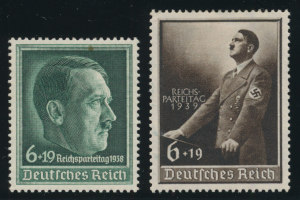Some countries are so vast philatelically that collectors break them down into more bite sized units. Some philatelists try to collect all of the German area, but with over a million collectible varieties by the Michel catalog, the latest Lighthouse specialty albums for this country runs to over 25 volumes and has a retail value for the albums alone of over $5,000 (a price for albums that is more than the value of most collections that are in them). So collectors have divided Germany and Area into several main categories—States, Germany Proper, Colonies and Offices, Berlin, GDR, Plebiscites, and Occupations. And specialists have divided down these sub-groups even more. Germany Proper is collected as Empire and Federal Republic, with the most popular subdivision being the Third Reich.
Hitler took over Germany in 1932, and the period of Nazi rule of Germany is called the Third Reich. The stamp issuing policies of that nation changed immediately. This is why Third Reich collecting has been so popular—it is so distinctive. Most Third Reich stamps depict Hitler himself; this served two purposes. One of the characteristics of fascism is a fetishization of the leader. He or she becomes the embodiment of the country and its aspirations. So Hitler would have been on a disproportionate number of Third Reich stamps even if he hadn’t negotiated a sweetheart deal with the German Post Office. Hitler received no pay for his job as Chancellor of the Reich. He was well paid, however, for licensing his likeness for use on German postage stamps.
Collectors have had a problematic relationship with Third Reich stamps, and this has affected their popularity over the years. In the immediate post-WWII period, stamps with Hitler’s picture on it were avoided like the plague. Hitler was responsible for nearly 60 million deaths, and feelings after the war were very negative about him. Certainly he has not been the beneficiary of revisionist history. He is still considered one of the top three or four brutal murderers of all time. But, as memories have faded and, more significantly, people who experienced his cruelty first hand have died, Third Reich collecting has become more popular.
In many respects Third Reich philately embodies many of the more interesting aspects of our hobby. Look how the character of German stamp design changed from 1932-35. There is a growing aggressiveness in the designs, and one can feel the militarism of Germany and the mythic fantasies that were the underpinnings of Nazism. It is a relatively inexpensive area to collect—the entire Third Reich issues of Germany can be had for well under a thousand dollars. Most of the stamps are relatively common. As Hitler was phenomenally popular, especially before about 1943 when Germany began losing the war, and as Hitler was paid by the image, Germany was pretty well papered over with Hitler stamps during this period. And despite the devastation of the war and the hatred of Hitler during the subsequent post-war period, huge quantities of many of these stamp survive, though there are a few scarce items which add spice to the collection. From a historical standpoint, there are few philatelic periods more interesting and affordable than the Third Reich.

